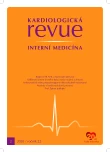Does sacubitril-valsartan have an antiarrhythmic or a pro-arrhythmic effect in patients with heart failure?
Authors:
Málek F.
Authors‘ workplace:
Kardiovaskulární centrum, Nemocnice Na Homolce, Praha
Published in:
Kardiol Rev Int Med 2020, 22(2): 78-81
Overview
Angiotensin receptor and neprilysin inhibitor sacubitril-valsartan has been shown to reduce the risk of cardiovascular mortality and the risk of heart failure hospitalisations compared to the standard treatment with enalapril in the PARADIGM-HF randomised comparative clinical outcome study. The cardiovascular mortality risk reduction was caused in part by the reduction of the risk of sudden cardiac death. The sudden death risk reduction may be caused by the indirect antiarrhythmic effect of sacubitril-valsartan, which is explained by a reverse ventricular remodelling and a decrease in the extent of myocardial fibrosis. Despite these facts, some papers have brought information about the potential pro-arrhythmic effect of sacubitril-valsartan.
Keywords:
heart failure – sacubitril-valsartan – ventricular arrhythmias
Sources
1. McMurray JJ, Packer M, Desai AS et al. Angiotensin neprilysin inhibition versus enalapril in heart failure. N Engl J Med 2014; 371(11): 993–1004. doi: 10.1056/ NEJMoa1409077.
2. Desai AS, McMurray JJV, Packer M et al. Effect of the angiotensin-receptor-neprilysin inhibitor LCZ696 compared with enalapril on mode of death in heart failure patients. Eur Heart J 2015; 36(30): 1990–1997. doi: 10.1093/ eurheartj/ ehv186.
3. Zile MR, O’Meara E, Claggett B et al. Efects of sacubitril/ valsartan on biomarkers of extracellular matrix regulation in patients with HFrEF. J Am Coll Cardiol 2019; 73(7): 795–806. doi: 10.1016/ j.jacc.2018.11.042.
4. Januzzi JI, Prescott MF, Butler J et al. For PROVE-HF investigators association of change in N-terminal pro-B-Type natriuretic peptide following initiation of sacubitril-valsartan treatment with cardiac structure and function in patients with heart failure with reduced ejection faction. JAMA 2019: 322(11): 1085. doi: 10.1001/ jama.2019.12821.
5. Desai AS, Solomon SD, Shah AM et al. The EVALUATE-HF Investigators. Effect of sacubitril-valsartan vs enalapril on aortic stiffness in patients with heart failure and reduced ejection fraction: a randomized clinical trial. JAMA 2019; 322(11): 1077. doi: 10.1001/ jama.2019.12843.
6. De Diego C, Gonzáles-Torres L, Nunez JM et al. Effects of angiotensin-neprilysin inhibition compared to angiotensin inhibition on ventricular arrhythmias in reduced ejection fraction patients under continuous remote monitoring of implantable defibrillator devices. Heart Rhythm 2018; 15(3): 395–402. doi: 10.1016/ j.hrthm.2017.11.012.
7. Goncalves AV, Pereira-da-Silva T, Galrinho A et al. Antiarrhythmic effect of sacubitril-valsartan: cause or consequence of clinical improvement? J Clin Med 2019; 8(6): 869. doi: 10.3390/ jcm8060869.
8. Martens P, Nuyens D, Rivero-Ayerza M et al. Sacubitril/ valsartan reduces ventricular arrhythmias in parallel with left ventricular reverse remodeling in heart failure with reduced ejection fraction. Clin Res Cardiol 2019; 108(10): 1074–1082. doi: 10.1007/ s00392-019-01440-y.
9. El-Battrawy I, Pilsinger C, Liebe V et al. Impact of sacubitril/ valsartan on the long-term incidence of ventricular arrhythmias in chronic heart failure patients. J Clin Med 2019; 8(10): 1582. doi: 10.3390/ jcm8101582.
10. Vincent L, Juárez M, Martín I et al. Ventricular arrhythmc storm after initiating sacubitril/ valsartan. Cardiology 2018; 139(2): 119–123. doi: 10.1159/ 000486410.
11. Vincent L, Martínez-Sellés M. Can sacubitril/ valsartan have a proarrhythmic effect in some high-risk patients? Cardiology 2019; 143(1): 34–35. doi: 10.1159/ 000500193.
12. Dujka L, Vránová J, Šimon J et al. Effect of loading dose of sacubitril-valsartan on the incidence of ventricular tachycardia as assessed by ICD interrogation - single center experience. Eur J Heart Fail 2019; 21 (Suppl 1): 5–592. doi: 10.1002/ ejhf.1488.
13. Marti CN, Fonarrow GC, Anker SD et al. Medication dosing for heart failure with reduced ejection fraction – opportunities and challenges. Eur J Heart Fail 2019; 21(3): 286–296. doi: 10.1002/ ejhf.1351.
Labels
Paediatric cardiology Internal medicine Cardiac surgery CardiologyArticle was published in
Cardiology Review

2020 Issue 2
Most read in this issue
- Modified Valsalva manoeuvre in pre-hospital care – a case report
- Urapidil – an antihypertensive drug with a dual action mechanism
- Clinical experience in the use of the infusion fixed combination Neodolpasse (diclofenac/ orphenadrine) in the postoperative period in cardiac surgery patients
- Cardiovascular prevention news
